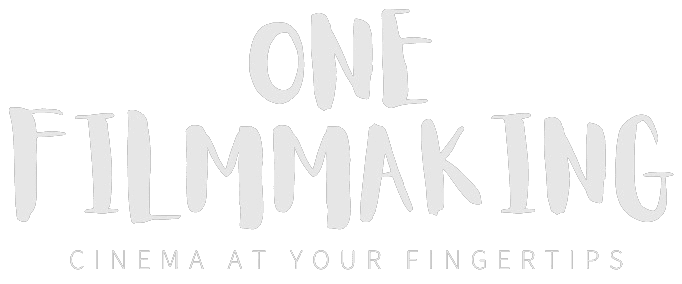Table of Contents – Greco-Roman Art
The Greek City States
- After the Cycladic States declined other Greek City States began taking control of the Aegean Sea
- This group of city states created their own forms of governance (democracy), philosophy, and arts
- The most important of these city states were:
- Iona
- Sparta
- Athens
- Macedonia
- The importance of these city states lasted until the Macedonian Kings conquered the area and united it under one crown
- Due to the trade routs throughout the Aegean the Greek City states became a melting pot of cultures and ideas
Periods of Greek Art
- The Greek Art can be divided into four Distinct phases:
- Geometric
- Archaic
- Classical
- Hellenistic
- No other culture has had as far-reaching or lasting an influence on art and civilization as that of ancient Greece and Rome. Most of the world’s Politics, Art, Culture, Philosophies, Literature and Science, even today has its roots from the Greek and Roman antiquities.
- Politics – Democracy, Electoral process, Republics, Socialism , Communism, etc.
- Art – Entire Western Art History – from the Renaissance till date
- Philosophy – Socrates, Pluto, Aristotle, Euclid and many others,
- Literature – Homer’s Iliad and Odyssey, Oedipus and many more
- Game & Sports – Olympic Games
- Science and Technology – Water Mill, Alarm Clock, Geometry and mathematics, Pythagoras theorem, Hydro – thermo dynamics, astronomy, cartography, alchemy, etc.
Geometric Period
Pottery
Early Grecian Pottery – the first abstract art?
- These kraters were used a grave markers or mourning vessels
- The decorations are arranged in horizontal bands. The motifs in these bands are highly abstracted and are found throughout the later periods of Greek pottery
- The meander is very prominent in these types of kraters
- Very detailed lines are used to create the images of people (see the top middle band) and animals (see the bottom middle band)
- This very distinctive style is the beginning of what we know as Greek Black-Figure painting
- The early images as Greece peeked out of their darkness came in the 8th century as well
Black Pottery – Bilingual Black Figure Paintin
- As the styles of pottery painting developed the forms of Black-Figure painting became very popular
- Bilingual painting is said to have been created by the painter Andokides in around 530 BCE
- Bilingual painting takes the normal techniques used in the creation of Black-Figure paintings and reverses their contrast
- Black on Neutral
- Neutral on Black
- These styles are place on opposite sides of a piece of pottery creating an interesting contrast
- Achilles and Ajax Playing a Dice Game is probably the most famous of all Black-Figure (Bilingual) Amphora
- Due to highly religious most often the subject of the paintings varied depicting from Greek mythology to contemporary scenes of activities such as dual, fighting, sports, chariot racing, hunting, etc.
- In the later stages we see that the human figurines are represented more and more realistically.
- One side is a neutral color on a black background while the other side is a black color on a neutral background (see the image to the right)
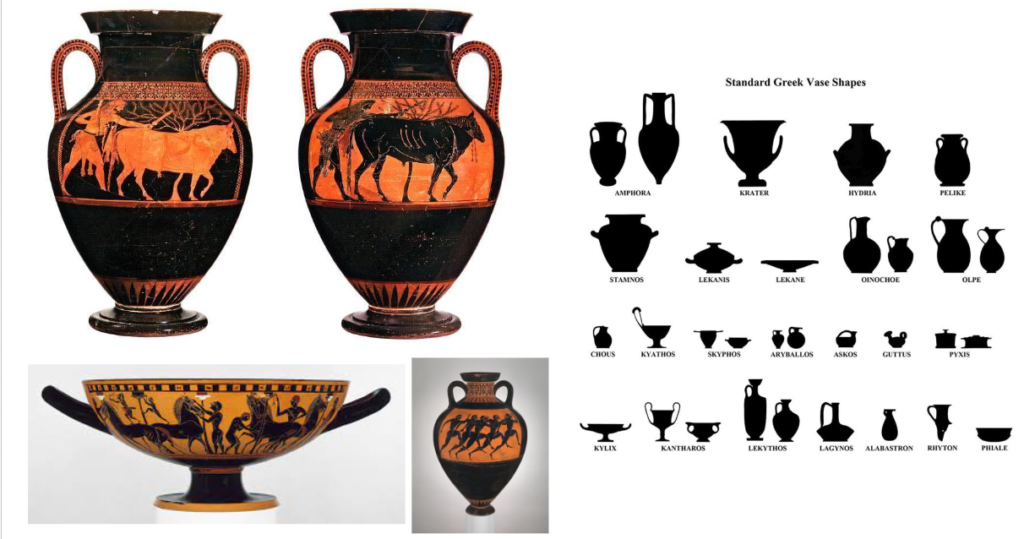
The Influence of Figure Painting on Later Civilizations
- The development of early Figure painting on pottery influenced the way that images of people were created in later Greek city states
- Greek pottery painters began rejecting the composite forms (Egyptian style) of human representation
- Although this meant that human forms were harder to distinguish it gave the forms a more realistic representation
- If we look for instance at the wrestling figures in Herakles Wrestling Antaios (see the image to the right)
- the images are put into a position that is meant to represent the reality of wrestling, and not to merely represent the most important parts of the human form
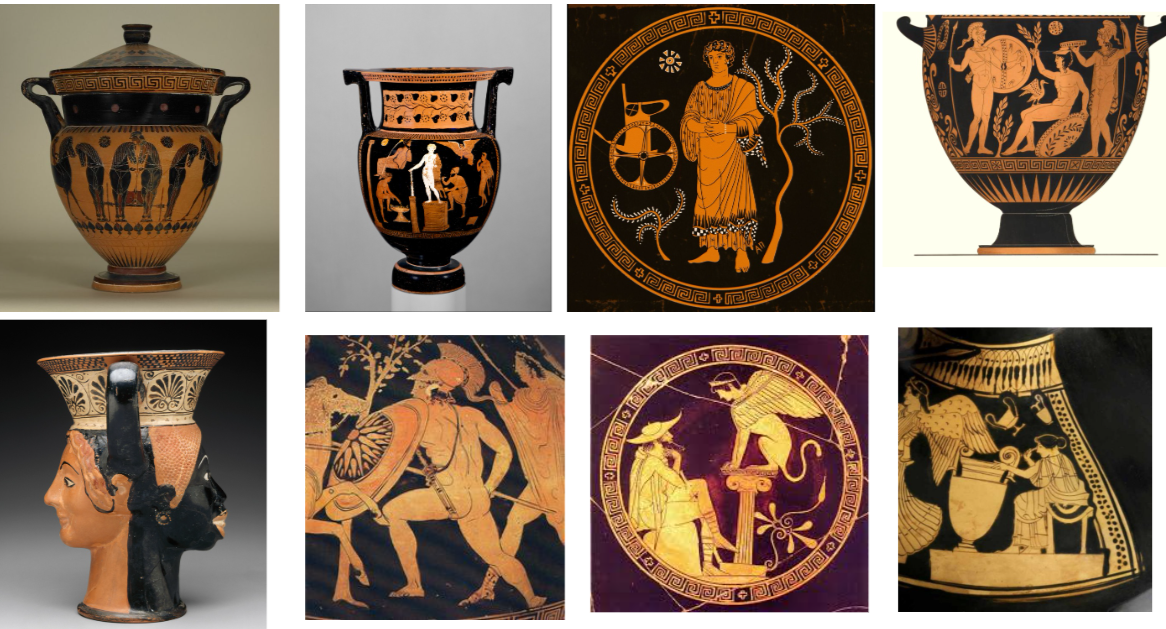
Later Civilizations – white-ground pottery
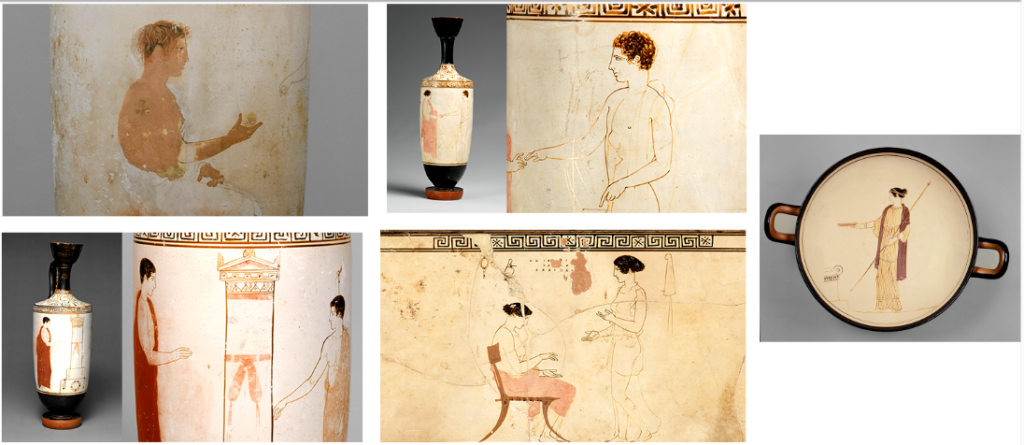
Wall Paintings
Greek Mythology in Wall Paintings
- Many of the wall paintings found throughout Greece contain images relating to Greek Mythology and history
- The Ancient Greeks were very concerned with their connection to their gods, and how the gods shaped their culture and history
- They used very detailed images of their gods as ways of expressing them here on earth
- The Greeks believed that if an image looked like a god that it was the real god
- Through these life like depictions of the gods the Greeks felt that they could communicate on a daily basis with the gods that they worshiped
- These forms were admired by later civilizations such as the Romans and Byzantines
- Later Christians (in the Roman Empire) used this same style as away to depict their religion underground in their secret churches
- It was the first time that the Gods were shown in the image of human. Hence the imegery shifted towards realism.
Battle of Issus, – November 5, 333 B.C.E. in what is now modern-day Turkey .
It took place between the (Hellenic League) forces of the Macedonian-Greek Alexander the Great and the (Achaemenid Persian) forces of Darius III— a struggle which would ultimately result in a victory for Alexander.

The Rule of Alexander the Great
- In the later Greek eras wall paintings were used as a form of propaganda
- The Macedonians were the first peoples of Ancient Greece to use painting as a form of propaganda
- These paintings, and mosaics, always show Alexander the Great (or other rulers of Macedonia) doing heroic things such as:
- Hunting (see the image to the right)
- Conquering peoples
- Giving rule and order to peoples they have conquered
Classical Architecture
Classical Architecture – Temple Structure : The Parthenon
- The most important of all Greek buildings were those of the temples
- The first major work that was rebuilt after the Persians destroyed the Acropolis was The Parthenon, dedicated to the goddess Athena (protector of Athens)
- Greek temples were normally created with the same plans
- Although their design changed over time the overall structure of temples stayed relatively the same
- The center of the temple contains a Cella and a Pronaos (where the main statue of the god / goddess is housed or worshiped)
- Surrounding the inner sanctuary is a Portico (an open air area that has columns, much like a porch)
- In the outside area commoners would gather to witness ceremonies, as only priests and priestesses were allowed in the inner sanctuary
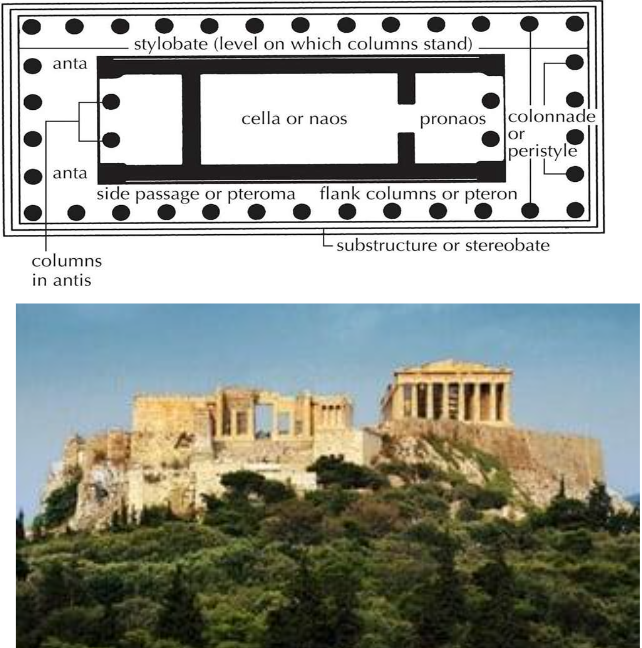
- Through the use of advanced mathematics the ancient Greeks were able to create large scale temple constructions
- One of the most important developments can be seen in the Greek column
- If we look at the temple of Hera from the side (see the image to the right) we can see that the columns look like thy are bulging in the middle
- This is meant to make the building look straight and not kike falling over when looked at head on as it have normally appeared due to foreshorting.
- The Greeks Build their massive architectural temples using mathematical formulas such as Golden Rectangle, Golden curve and section.

Pillars – The Doric and Ionic Orders
- In ancient Greece there were two main forms of columns
- Doric
- Rests on the stylobate
- Vertical flutes
- Cushion shaped capital
- Rectangular abacus
- Early Aegean and Greek city states
- Ionic
- Rests on the stylobate
- Vertical flutes
- Spiral shaped capital
- Rhombus shped abacus
- Athens
- Most of the later European Architecture incorporated these architectural elements during the Neo-classical Art Movement
The Greek Theatre
- Theatre was an important part of Greek culture and medicinal practices
- They are not only amazing examples of architecture and engineering, but also scientific planning
- The Theater of Epidauros is 387 feet in diameter and seats around 12,000 people
- The size of this theater shows us that the Greeks had to have a good understanding of engineering for sound resonance
- Greek theatres are known for the ability of every spectator to hear the actors clearly
- This was done through the arch of the theatre, as well as resonance catchers
Athens Acropolis –Parthenon
- Acropolis is any citadel or complex built on a high hill. The name is derived from the Greek word akro – high or extreme/extremity/edge and polis – city, translated to City in the air.
- It holds the Parthenon, temple of the Greek goddess Athena. The city is called Athens after her name.
- According to tale, the early king Cecrops wanted the city to be named for himself. But it was so beautiful that the gods felt that the city deserved an immortal name. Athena and Poseidon contented. Athena Wins!
- Poseidon – struck the rock and brought fourth water (salty)
- Athena – dropped a seed and an olive tree grew. Many uses of olive tree
- Persian King Xerxes I, burned the city of Athens and destroyed the temples of Acropolis.
- The Acropolis was rebuilt under the guidance of the great general and statesman Percles of Athens.
- The supervision of the construction was done under the great sculptor and a mathematician named Phidias. Who also made the temple of Zeus in Olympia.
Athens Acropolis –Parthenon


Chryselephantine – Statue of Athena Parthenos
- Acropolis is any citadel or complex built on a high hill. The name is derived from the Greek word akro – high or extreme/extremity/edge and polis – city, translated to City in the air.
- The statue measured, according to Pliny the Elder, 26 cubits (about 38 feet high), probably counting its base.
- On the front of this base, a carved plaque evoked the birth of Pandora in the presence of twenty gods.
- The posture – The left leg was a little bent, the knee forward, the heel not posing on the ground. (This posture seems to have been chosen more for technical reasons of balance and volume of the lower manikin than for aesthetic reasons).
- The goddess’ face was also ivory, probably with a neutral expression, as was then the aesthetic rule. However, she may have had her lips ajar, symbolizing the breath of life.
- The left hand held her shield and spear. At her feet on the left side, her sacred snake nestled. In her right hand, perhaps leaning on a column to support her, she held a statue of Nike, (2 m high). This symbolization of victory.
- The snake on the shield perhaps represented the Chthonian powers that would have been present on the acropolis from the beginning.
The Origins of Commercial Architecture
- It is during Ancient Greece that we see the development of architecture for commercial purposes
- Developed during the late Hellenistic periods
- Created city centers called agoras
- Surrounding these agoras were stoas, or large covered buildings filled with shops and offices
- These buildings were usually less decorated than the temples, and were highly utilitarian
- These same buildings were the inspiration for everything from the Roman Forum to the modern day mall
The Origins of Commercial Architecture

Monumental Greek Architecture Outside of Greece
- One of the greatest Greek constructions found in Anatolia is that of the Pergamon
- In the Pergamon there is the Temple – Alter of Zeus
- The structure is a mix of Greek Architecture and sculpture
- The friezes one the outside of the alter are larger than life size and are very detailed an imposing
- The subject of the friezes discusses the Greek Mythology – the battle of Zeus and the other Gods, against the giants (Titans) for control of the worlds
- This is part of the Greek origin story and its depiction would have been very important to Greeks at the time

Hellenistic Period : The Front of the Altar : A battle for Hellenistic times
- Athena grasps the giant Alkyoneos by his unruly wavy hair, pulling his face to the left.
- His right arm grasps in vain at Athena’s forearm. A serpent, the agent of Athena, restrains the giant’s body and simultaneously exposes his anatomy to the viewer. His face, with its wrinkled brow and open mouth, exaggerates his suffering.
- Ge, goddess of the earth and mother of giants, emerges from the ground to beg for her son’s life.
The Front of the Altar : A battle for Hellenistic times
- The giants from the Zeus panel are rendered from three distinct perspectives.
- One, directly to Zeus’ left, kneels on his left leg, his body not nearly as extended as Athena’s opponent.
- A second, furthest from Zeus, shows us his muscular back, buttocks, and serpentine legs as he turns toward the god with his bearded face in profile.
- The third, to Zeus’ right, has been pierced by Zeus’ weapon, the thunderbolt, and sits in profile view, wounded on the ground. Although barely preserved, just to the right of this wounded giant the figure of Herakles can be detected by a paw from the Nemean lion’s skin (an attribute of the Greek hero Herakles).
- Herakles’ essential role in the gigantomachy has been appropriately emphasized through his proximity to Zeus
Sculpture
Bronze Age: Greek Sculptures
- The 3 styles of Greek Sculpture
1. Archaic – stiff body pose, feet together, and arms close to the body.
2. Classical – more lifelike body, more natural form with movement, calmness, appearance of the contrapposto pose
3. Hellenistic – evokes emotion, more lifelike detail, greater movement
- The earliest forms of Greek sculpture are bronze
- Mantiklos Apollo: Votive statuette of Apollo
- Marks of attachment on the top of the head, forehead, left hand
- This shows us that the image might have been a warrior figure that was holding a spear and wearing a helmet
- On the legs is inscribed this sentence:
- “Mantiklos donated me as a tithe to the far shooter, the bearer of the Silver Bow. You, Phoebus (Apollo) give something pleasing in return.”

Archaic Period: Bronze Age – Depiction of the Gods
- This statue shows us that images of the gods, and depicting mythical stories, was important to the Greeks starting earlier that previously thought
- There is a naked man (possibly Heracles) shown in combat with a centaur (Nessos)
- Both Heracles and Centaurs are important parts of the Greek mythical traditions
- We can see in these sculptures a struggle to find a way to take an oral tradition and make it visual
- This becomes very clear when we look at the body of the Centaur
- The connection between the human part of the body and the animal part of the body is very crude but still expresses the meaning
Archaic Period: The Kore (Korai)
- Free-standing ancient Greek sculpture
- Young female figures
- Carved with thick drapery, and have elaborate hair styles
- Often painted
- Relaxed, Natural posture
- Believed to be representations of the goddess Persephone
- Found in many Greek city states
- The most famous come from Athens
- The Kouros (Kouroi) Male equivalent of the Kore
- Restrained smile
- Kouroi are always nude

Breaking the Archaic Style: The Calf Bearer
- As time went on the Greeks started transforming the Kouroi into their own style The Moschophoros (Calf Bearer) was found in the Athenian Acropolis Shows Rhonbos offering a calf to the goddess Athena
- Although the left foot is forward (Egyptian) and he is nude (Greek) there are many differences in his style
- Beard (trimmed and no mustache – shows not young)
- Thin cloak (drapery)
- Structure Unity (Man and animal – arms not down, rather forms a ‘X’ connecting with the legs of the animal)
- Eyes (made of colored stone)
- The Lips (bearers a archaic smile – a trend began in 6th century BC)
- His expression gives us the impression he is positive Person.
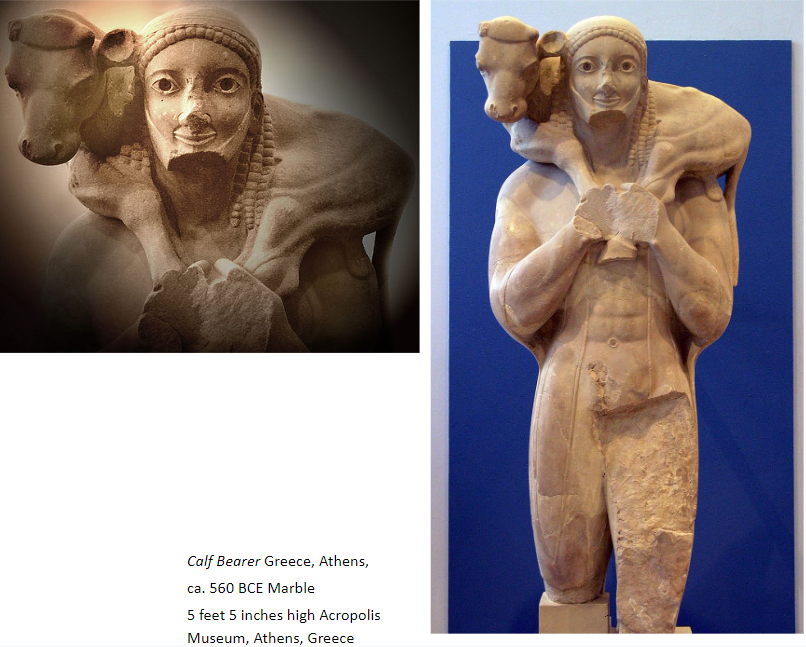
Making Sculpture a part of the temple:
The Temple of Aphaia in Aegina
- The Ancient Greeks were experts at putting sculpture into their architecture
- Most temples in Ancient Greece were lined (around the top) with sculptures depicting historical scenes or mythological scenes
- These sculptures were either engraved or were in the round
- The pediments are dedicated to Athena
- Pediments are the triangular upper roof parts of temples
- Groups of warriors lay dying in protection of the goddess Athena
- These warriors lay in positions that allow them to fit nicely into the corners of the triangular pediments
- Depictions of the warriors Hercules and Agamemnon
- Later influences on Neoclassicism in Europe

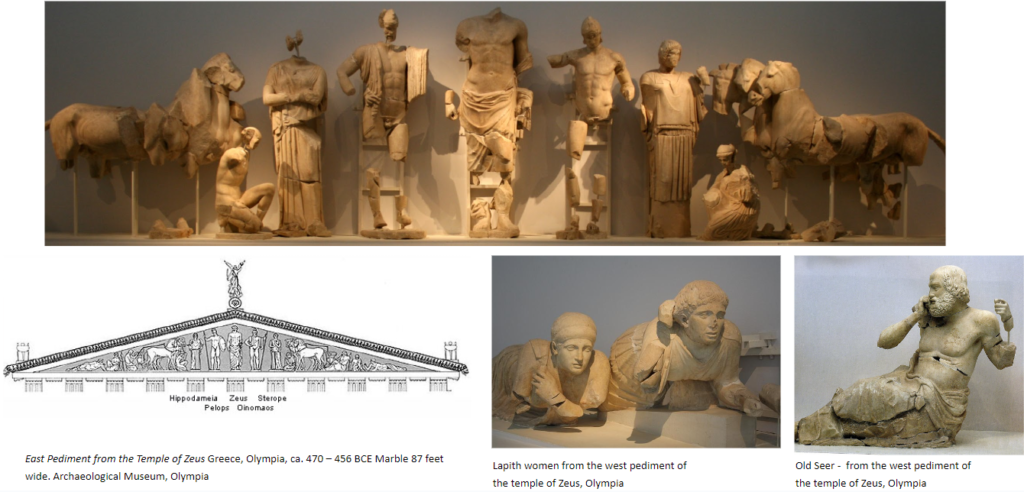
Classical Period: Kritos Boy (Kritian Boy)
- Belongs to the early classical period of Greek sculpture
- First statue known to use contraposto (This artistic term usually refers to a standing human figure carrying its weight on one leg so that the opposite hip rises to produce a relaxed curve in the body)
- Attributed to the Greek sculptor Kritios
- Smaller than life size
- The first example of sculptors trying to mimic exactly the human form
- The male body was idolized – hence more focus on male nude. Women were represented clothed.
- They were looking for perfection
- They were examining how different parts of the body act together to make the whole
- They were looking bellow the skin to see the function of the human form
- The Archaic Smile is finally dropped.
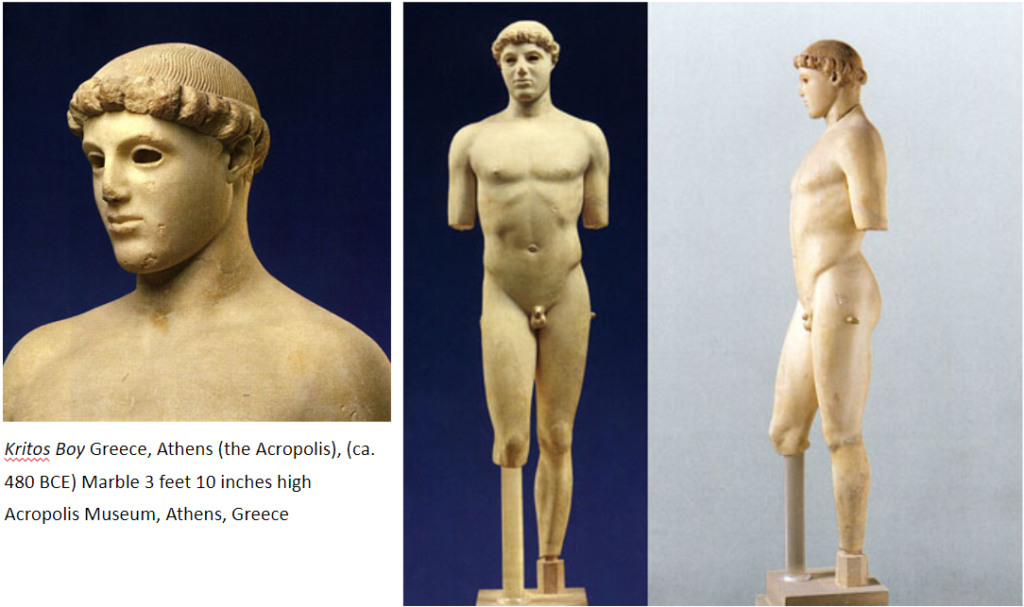
Polykleitos : Michelangelo of the Greek
- Ploykleitos – Renowned Greek Sculptor
- He wrote the Kanon (Canon). It is a system that explained the way to produce the perfect body form (especially for males)
- He known as the best sculptor of male human form
- He developed the Mathematical proportions of the human form
- Balance between muscular tensions and relaxation due to the chiastic principle that he relied on.
- Doryphoros is seen as one of this best works when using this mathematical style.
- This style allowed all Greek sculptures to look different while still looking relatively the same
- This sculpture was later copied by the Romans. Also the similar sensibility is observed in Donatello and Michelangelo’s David.

Myron: Discobolus ‘The Discuss thrower’
- Myron – Renowned Greek Sculptor was the first to achieve perfection in representation of human anatomy
- Discobolus (disco thrower) is the most copied statue in the history of art. The original does not exist, we only have Roman copies.
- Greek mostly men were very proud of their athletics, games and sporting. Most popular games were chariot racing, athletics such as marathon, disc and jabline throws, wrestling, etc.
- Being Patriarchal society, women were forbidden to participate in games. Women usually stayed indoors.
- They would train in Greek Gymnasium, sometime under personal trainers.
- The Greek started the Olympic Games – It was a religious and athletic festivals held every four years at the sanctuary of Zeus in Olympia, Greece. Competition was among representatives of several city-states and kingdoms of Ancient Greece.
Height of the Classical Period: Overly Realistic Human Forms
- Famese Herakles ( Weary Herakles) was 10.5 foot tall statute made out of white marble. It was copied many times in the ancient world
- It was found in the Baths of Caracalla in Rome
- It as liked by both the Greeks and the Romans as a depiction of the strength of men and the strength of the nation
- Subject: It depicts a muscular yet, weary, Hercules leaning on his wooden war-club, which has the skin of the Nemean lion he had previously killed, draped over it.
- It is based on the Greek Myth of Herakles performing his twelve labours. Myth: Hercules, killing the lion (Nemean) was his first undertaking of twelve nearly impossible tasks he performed.
- His last labour was to get the golden apple that grew in a garden at he northern edge if the world, guarded by the Ladon the hundred-headed dragon and also by the Hesperides, nymphs who were daughters of Atlas, the titan who held the sky and earth upon his shoulders.
Hellenistic Period: Golden Age of Greek Art
- This period dates from the death of Alexander the Great in 323 BCE to the emergence of Ancient Rome
- A number of the best-known works of Greek sculpture belong to this period
- Decadent style
- Golden Age of Classical Athens
- This period is categorized by its use of Hype-realism (extreme musculature) in males and draper in females, also exploring diverting from idealism rather showing the true nature of man.
- An inspiration for later Artistic styles
- Baroque
- Rococo
Hellenistic Period: Hyper-Realism
- Comes from a group of sculptures created to commemorate the victory of the Greeks over the Gauls
- The original bronzes may have been commissioned by Attalus I of Pergamon to celebrate his victory over the Galatians/Celtic of Anatolia.
- Epigonus – A court sculptor of the Attalid dynasty of Pergamon is believed to be the original sculptor of the pieces.
- There are no surviving Greek bronze versions, only roman marble copies
- Use of Drama: The postures of the characters are exaggerated and their bodies contort in every way. Each limb is spread out in different directions, which gives the feeling that the figures are coming to life.
- This style is better know as the Hellenistic Baroque: –Since the figures twist and turn as a real human body behave showing human emotion (pain and suffering).
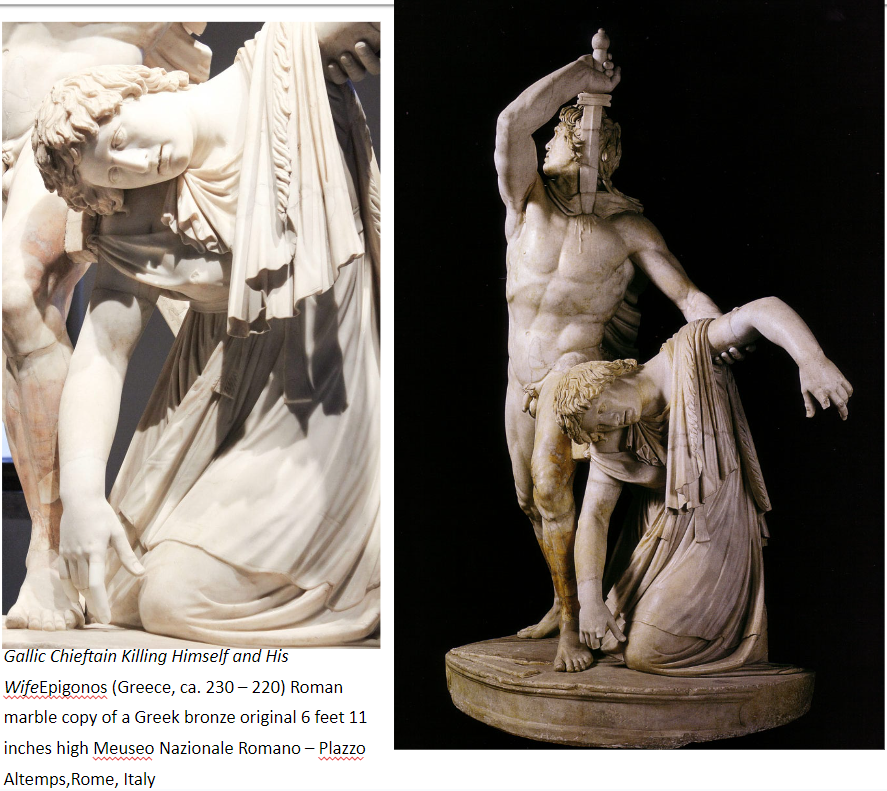
Hellenistic Period: Hyper-Realism
Nike of Samothrace
- Nike of Samothrace or the Winged Victory of Samothrace, depicted the Greek goddess of Victory (Nike) and a sea battle she was involved in.
- Originally stood in a temple where it was placed on a pedestal that was shaped like a ship
- Subject: The statute show a dramatic movement a if she descended from the heavens in mid storm. She has a forward moving posture implying to lead the army. She depicts a triumphant spirit
- Drapery: Nike is dressed in Chiton(Tunic), a a set of girdle placed under her breast and around the hips – a popular style in the 4th century BCE.
- The statute is left dominated perhaps to be viewed from the left hand side.
- This posture of the Nike is later been noticed in the Neo-classicism and Romanism period.


Hellenistic Period: Hyper-Realism
The Venus de Milo
- Depicts Aphrodite (Greek goddess of love and beauty)
- Shows the use of drapery in the intermittent stage before Hellenism
- Her body form is based off of the very rigid system of mathematics – Golden Proportion at its best.
- Although the statue is very well done its true fame is due to a French campaign to describe it as the greatest Greek statue of all time
- Possible reconstruction:
- Aphrodite holding a golden apple
- Aphrodite holding a spear and shield or a dove.


Hellenistic Period: Hyper-Realism – The Evolution of Bronze Sculpture
Seated Boxer
- Expresses the importance of athleticism in Ancient Greece.
- The amount of details in the way the body is formed shows us that they were not looking for glamour or idealism, but to show the boxer as he was
- Top heavy body
- Bruised face
- Broken nose
- Missing teeth
- Cauliflower ears
- One of the only original bronze Greek sculpture ever to be found intact
- Archeologist believe that this sculpture and many other found were deliberately buried during the antiquity
- Nobody sure why?

Hellenistic Period: Hyper-Realism
Laocoön and His Sons
- One of the most famous ancient sculptures ever!
- Follows Hellenistic tradition – Hyper Realism (Twist & Turn of the body)
- Subject: Shows the Trojan priest Laocoön and his sons Antiphantes and Thymbraeus being attacked by a sea serpent
- Depiction of Human agony: Very famous for its ability to show the distress and plight of the humans depicted through their facial features and body positions
- This sculpture, much like those of the Winged Victory, and the Venus di Milo, has been copied over and over again
- Famous Artist like Michelangelo, Raphael and Peter Paul Rubin studied this sculpture.
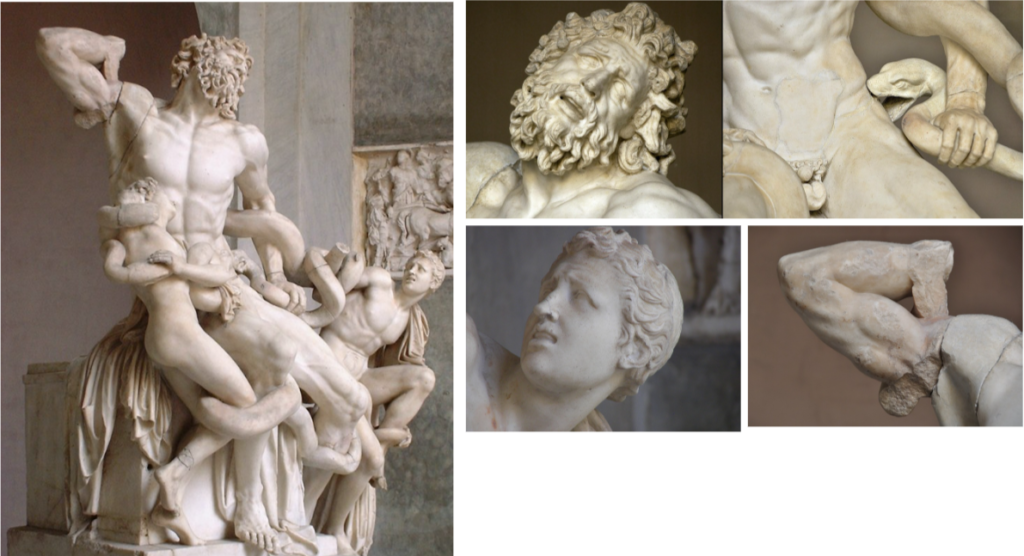
Article Credits/Mentor
Prof. Sh. Argha Sengupta
Department of Animation Cinema, SRFTI

